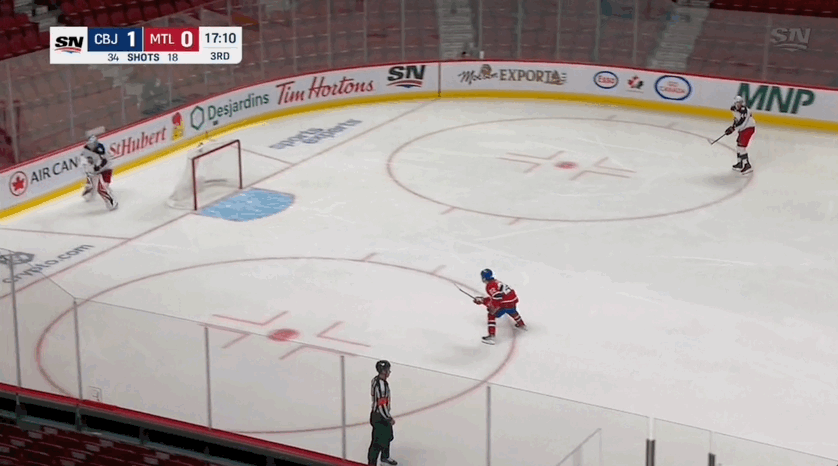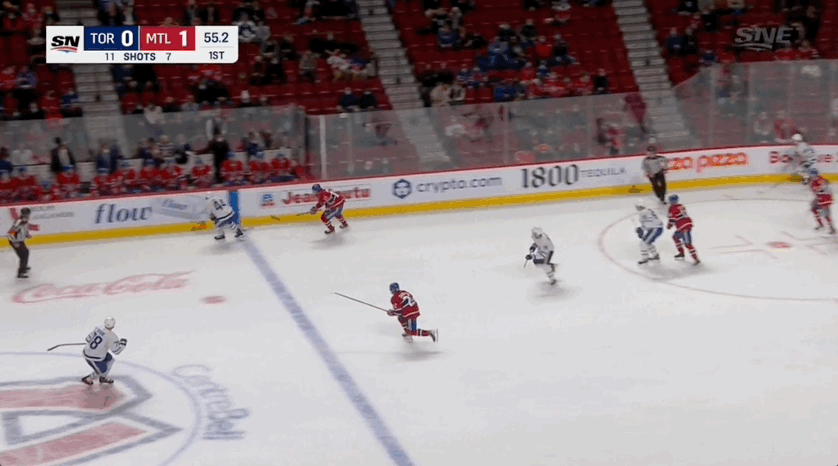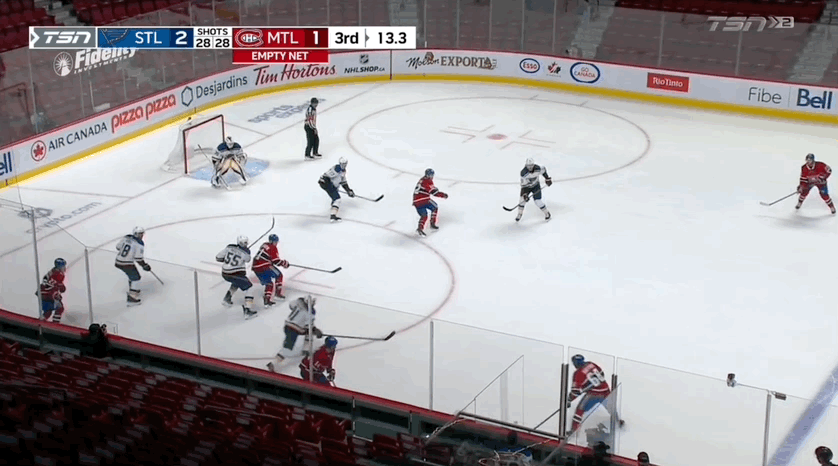Sometimes a coaching change can make all the difference in the world for a player to rebound. That sure seems to be the case for Cole Caufield of the Montreal Canadiens under Marty St. Louis.
The winger made his NHL debut last season, scoring four goals and five points in 10 games to end the regular season. He followed that up with another four goals, plus eight assists that showed some more dimension to his game, in 20 playoff games — though, even then his usage was suspect, including when he wasn’t in the lineup to open the post-season.
Despite becoming a key source of offence in the Canadiens’ run to the Stanley Cup Final, Caufield’s rookie season got off to a tough start this year. After netting just one point, an assist, in 10 games and seeing bottom-six minutes most nights, he was sent to the AHL. While he scored a goal in his third game back in the NHL from his two-week November stint in Laval and contributed a couple more helpers over the next stretch of games, his season was still far from ideal. The same could be said for most players in Montreal.
Enter St. Louis who took over as bench boss after the team dismissed head coach Dominique Ducharme. There have been some improvements across the board since the coaching change, and one of the most notable has fittingly come from a fellow short king in Caufield.
Ahead of the coaching change, the winger had tallied just one goal and eight points in 30 games. When accounting for minutes played, his all-situations scoring rate was 17th on the team among skaters with at least 100 minutes of ice time.
Fast-forward to the start of the St. Louis era and Caufield’s leading the team with six goals and 11 points in nine games. Even when accounting for ice time, his 4.29 points per 60 minutes rate still tops the rest of the Canadiens.
Speaking of his ice time, that’s been a major change along with the scoring — of course, the two are linked. More opportunity can boost confidence, and that increased production helps expand and maintain that role.
In all situations, Caufield averaged just 14:41 of ice time under Ducharme, and 11:42 at 5-on-5. Now with St. Louis in charge, Caufield's all situations minutes are up by almost three minutes on average to 17:31, which is second to only Nick Suzuki among the forwards. At 5-on-5, Caufield's average time has increased as well to 13:03.
That 5-on-5 play is where the winger has had the most success, scoring 70 per cent of his 11 points there.
What’s behind it?
Before the coaching change, it wasn’t for a lack of shooting from Caufield. He was third on the team in his shot attempt generation with 16.5 attempts per 60. But only around half of those attempts actually went on net and only about 43 per cent were taken from the slot.
As the heat map shows below, the majority of his attempts were concentrated to the left circle and he took few from in close — even though that’s where he net his single goal.

Since Feb. 9, however, there’s been quite a swing in his shot creation — and not from the volume since he’s somewhat level with 15.5 attempts per 60 (still third on the team). The difference is the quality of those shots, now with 82.4 per cent coming from the slot.
Before, he was attempting about 7.13 slot shots per 60. And now he’s generating 12.8 per 60 to lead the team. The heat map below puts that on display, with almost all of his attempts within that home plate area in front of the net and particularly concentrated between the face-off dots.

Unsurprisingly, that’s where all three of his 5-on-5 goals have come over the past nine games.

It’s possible that St. Louis’ more progressive approach is influencing Caufield's play. Rather than being so stringent in structure, he’s encouraging his players to ‘make reads’ as he explained in the early days of his tenure.
“In systems I feel like you box players in to be in a certain spot, and sometimes you don’t allow them to make reads because of it,” St. Louis said. “A concept is more playing with a little more instinct with ideas of how we want to be as a team. Now, there is structure inside concepts.”
The philosophy instilled by the new head coach, drawn from his playing experiences, allows more freedom to his players, including Caufield.
“I was a great player when I was allowed to make reads, because the best players make the best reads. But if you take the reads out of the equation, those best players become average,” St. Louis continued. “So, I want to make sure that I allow my best players to make reads, and I’d rather they make a bad one than not making a read at all. And sometimes in systems, there’s not much reads.”
By making reads, Caufield can ‘break’ the structure and play to his strengths that include looking for those openings in the dangerous areas of the ice. He can skate through defenders and get himself to the quality shooting areas when he sees an opening — and he’s not the only player in Montreal attempting this; it’s been evident in Josh Anderson’s game as well.
That likely is a key contributing factor to the upswing in rush chances for the winger. Caufield went from 2.89 slot shots per 60 generated off the rush to now a team-leading 5.06 over the past eight games.

Along with that freedom to play his game, the coach inspires more confidence, or a ‘swagger' as he described it, in his players — and that’s particularly important for more offensively inclined forwards who often are instructed to pick up on defensive structure sooner, which can weigh on their game elsewhere. It can also push a player into taking fewer risks, even if it leads to less production. That may have been the case in Montreal earlier this season and for Caufield when his ice time was particularly low.
Now, he’s being trusted in the key moments of a game and he’s delivering, like when trying to go ahead a goal during a 6-on-5.

And, in overtime.

The expectation isn’t to have a flawless game now and there’s more encouragement for Caufield to play to his instincts, which for the player dubbed ‘Small Goals Boy’ is to get crafty offensively and score.
“Maybe the change has gotten him to reset mentally,” St. Louis said of his rookie winger after the Canadiens’ win over the Maple Leafs. “He’s playing free. He makes mistakes sometimes, for sure. I made plenty of them on the ice. But he’s doing many more good things than making mistakes. So, a coach has to live a bit with those errors, so long as the good things are there.”
Now, Caufield’s improved his shot creation and maintained his passing rate (with a better completion rate). The expectation obviously is for a natural goal scorer like him to shoot — and he is — but continuing to set up his teammates is also key. He’s a sneaky good passer who can trick defenders into thinking he’s going to do what he does best, shoot.

That’s helping him drive play in the Canadiens’ top-six — who are now creating almost 55 per cent of the shots while he’s deployed compared to under 47 per cent pre-coaching change at 5-on-5.
Of course, it’s only nine games and that’s an incredibly small sample of play. But there’s been a clear change in the rookie winger’s game. Caufield’s playing to the strengths he established at all levels of his hockey career before puck drop of this season — and much of it appears to be stemming from the trust his new bench boss has in him and encouragement to play his game.
Data via Sportlogiq







COMMENTS
When submitting content, please abide by our submission guidelines, and avoid posting profanity, personal attacks or harassment. Should you violate our submissions guidelines, we reserve the right to remove your comments and block your account. Sportsnet reserves the right to close a story’s comment section at any time.